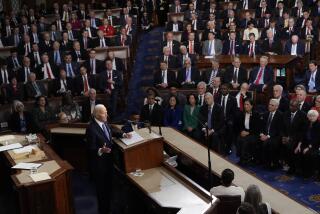Don’t expect 2018’s strong job growth to happen again this year, economists say
U.S. job growth was surprisingly strong in 2018, but don’t expect that to happen again this year, with economic headwinds intensifying for the country and rest of the world.
The federal government’s final employment report for 2018 is forecast to show employers added 180,000 jobs in December to bring the annual increase to 2.45 million, the most since 2015 — but the monthly estimate is the lowest median projection since last January. Economists surveyed by Bloomberg expect that to slow in 2019 to an average monthly pace of 156,000, for a total of 1.87 million, followed by 1.44 million in 2020, when President Trump is up for reelection.
Other key labor measures aren’t expected to improve far beyond current levels by year end. Economists project the jobless rate held steady last month at 3.7%, the lowest since 1969, and will edge down to 3.5% at the end of 2019. Wage gains last month are expected to have eased to 3% year-over-year from a post-recession high of 3.1% and then modestly re-accelerate during the year.
The prospect of less-robust job growth is the latest in a slew of risks stacking up for the world’s largest economy even as it heads for its longest expansion on record. It comes alongside warning signs from housing and manufacturing, among other industries, and projected weakening in both U.S. and global growth this year. A waning boost from Trump’s tax cuts and government spending will add to policymakers’ challenges.
“The economy accelerated in 2018 and employment with it for a pretty simple and obvious reason: We had a pretty big fiscal stimulus,” said Lewis Alexander, chief U.S. economist at Nomura Securities International. “The boost to growth from fiscal policy is not sustainable,” he said, adding that he expects slowing of both the economic expansion and employment growth.
Data released Thursday by the ADP Research Institute indicated that companies in December added the most workers to U.S. payrolls in almost two years. Private payrolls grew by 271,000, exceeding forecasts, after a downward-revised 157,000 advance in November.
A separate report Thursday from the Labor Department showed filings for unemployment benefits rose to a four-week high of 231,000 in the week that ended Dec. 29, exceeding the median estimate of economists in Bloomberg’s survey.
Barclays sees payroll growth slowing from an average pace of about 200,000 a month last year to about 160,000 a month this year. “Our outlook for slower growth in activity in 2019 relative to last year on account of a smaller impulse from fiscal stimulus leads us to expect less employment growth this year,” chief U.S. economist Michael Gapen said in a note.
The jobs report for November showed a payroll increase of 155,000, a tally that missed all estimates in Bloomberg’s survey calling for a gain of 198,000. The same report revised the October reading down to 237,000, from 250,000.
Maintaining strength in hiring may depend on continued contributions in key sectors such as manufacturing, which even before the December figures had added more jobs than any year since 1997. A Labor Department report due out Friday is forecast to show factory jobs rose by 20,000, which would bring the full-year increase to 269,000.
Elsewhere in the tallies for goods-producing sectors, mining and natural resources jobs are within reach of their best gain since 2011, and construction is holding up. For private services jobs, more than half the 1.68 million hires already on the books for 2018 have been in two categories: education and health services, and professional and business services.
Federal Reserve policymakers have stayed sanguine on the labor market, with Chairman Jerome Powell noting that increasing tightness should help keep inflation around the central bank’s 2% objective. Fed officials at their final 2018 meeting kept their end-of-2019 jobless rate forecast at 3.5%.
But as downbeat reports stack up, pressure increases on the Fed to signal a pause on interest-rate increases. Policymakers have said they intend to slow the pace of hikes this year. As they raised rates in December — their fourth hike in 2018 — they penciled in just two hikes for 2019, the median projection of governors and district presidents shows. That’s still more than many investors anticipate, with rate futures pointing to no moves in 2019 and a potential rate cut next year.
“A substantial surprise in the jobs number, either higher or lower, would likely elicit a significant market reaction,” Citigroup economist Veronica Clark said in a report. “An upside surprise could increase market expectations for rate hikes in 2019, while a downside surprise could lead markets to price a higher probability that exceptional U.S. growth is not immune from declining equity prices and slowing global growth.”






